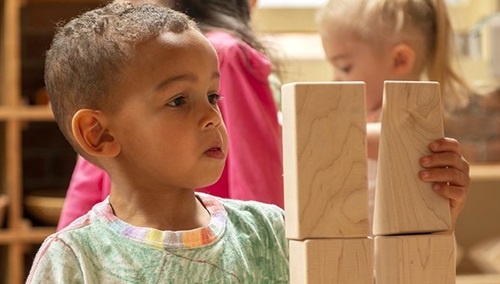Full Diversity:
Meeting the Needs of Young Children with Developmental Delays
| September 2021Recently there has been increased interest in issues of diversity, equality, and inclusion in the early childhood field. This is the direct result of major events that have occurred throughout the country. Articles in a variety of publications have reflected this interest. Most of this focus has been on race, ethnicity, language, sexual orientation, and gender identity. Surprisingly, however, little attention has focused on young children with developmental delays—or special needs*.
These children–age birth to 8 years old–can be found within all other diversity groups, including gender, race, ethnicity, and recent immigrants; and in many ways they pose a unique challenge to the early childhood field. They are often systemically discriminated against in early childhood programs and elementary schools.
Some of the challenges the early childhood field faces in supporting the needs of children with developmental delays, include:
- A disproportionate number of minorities and boys are placed in special education (and a disproportionate number of Asian and White children in G/T programs)(Harry & Klingner, 2007).
- Two distinctly different programs serve these children—one for children birth to age three; the other age three and older. In most communities these two programs are administered by different community agencies; also, each state and each school district implement these programs differently.
- A dearth of special education specialists with knowledge of how young children develop and learn. This is often exaggerated because the programs that serve children age 3 and above are administered through the local K-12 public school district, not by early childhood specialists.
- A conflict between developmentally appropriate practice (DAP)—the philosophy underling most early childhood programs—and an approach of direct intervention and instruction practiced by the field of special education (Carta, Schwartz, Atwater & McConnell, 1991).
- The common practice of many public schools to force parents to move their children with delays from their home program—private, home-based, or Head Start—to the local public school in order for them to receive services.
- A lack of expertise in non-public school early childhood settings and schools, and a lack of adequate financial and professional support to assist these programs to fully serve children with developmental delays.
- Few valid and reliable assessment instruments to evaluate young children from diverse backgrounds and children whose first language is not English—or who are simply delayed in language development (Gargiulo & Kilgo, 2020).
- The fact that children with developmental delays are more likely to be bullied than other young children.
But maybe the biggest challenge for children with developmental delays in early childhood programs is an almost universally accepted approach that focuses activities and learning experiences on areas of deficit (i.e. behavior) of these children, at the expense of all the critical early childhood activities of art, music, dance, use of the outdoors, and play (Harry & Klingner, 2006).
At the same time early childhood programs are struggling with these challenges, experts and advocates passionately focus on early intervention of young children with delays to minimize the impact of a disability or delay on their future academic learning and development (Gargiulo & Kilgo, 2020).
History
Our history of educating children with disabilities is shameful! In 1954 the U.S. Supreme Court declared racial segregation in public schools illegal (although it took until the Civil Rights movement of the 1960s to fully implement this decision). However, it was not until 1975, as the direct result of legal challenges by mothers of children with disabilities, that discrimination against K-12 children with disabilities was declared illegal. Before then at best these children were relegated to custodial care in a room hidden in the back of the local school; at worst, they were simply denied entry into school (Gargiulo & Kilgo, 2020). Preschoolers (age 3–5) were not covered by the federal law until 1991-92. Today IDEA (Individuals with Disabilities Education Act) covers children birth to age 21, with programs for 3-21 year-olds administered by the local school district. IDEA also provides some support for children at home and in many private early childhood programs and elementary schools (U.S. Department of Education, 2012).
Today some children with disabilities are still discriminated against by being forcefully removed from their peers, prevented from enjoying many personally meaningful learning activities, and even denied access to certain programs—even within their own schools.
Ideas for Working with Young Children with Developmental Delays
While meeting the unique needs of young children with developmental delays is complex and fraught with challenges, these are some general ideas to address the needs of this vulnerable population:
- Make sure your curriculum is truly developmentally appropriate, with lots of play, art, music, and dance.
- Make sure academic and behavioral expectations—especially around restricting movement and direct instruction—are truly developmental.
- Make sure all activities can be adjusted—both easier and more difficult.
- Before recommending a child be assessed for a delay or disability, examine all other possible reasons for the child’s difficulties (i.e. inappropriate expectations, the classroom environment, non-English speaking children, their home situation, and so on). Studies show that screening recommendations can become self-fulfilling prophecies (Wardle, 2017).
- Give all students—including those with developmental delays—many opportunities to succeed throughout the day.
- If a child has been assigned a disability label—i.e. ADHD or autism spectrum disorder—do not use it around children, parents, or other teachers (except those who need this information), and never assign a child a label without due process (assessments and parent permission). Do not allow children to use a label to describe a child with a delay.
- Never use what a child likes to do or is good at doing as a reward for achieving skills or tasks. Affirmations should not have to be earned. Further, never take away what a child can do and is good at doing as a punishment.
- Make sure a child’s treatment or therapy does not interfere with activities the child likes and enjoys, such as playing with other children or outdoor activities. Effective therapy is embedded within pleasurable and ongoing classroom activities.
- Regularly monitor the way adults and children respond to each other in the program. Who gets punished? Who gets rewarded? Make sure children with delays receive lots of affirmations.
Early childhood programs need to work closely with parents regarding intervention and the appropriate placement of a child with a disability. IDEA requires children to be placed in a natural environment, which means the environment they would be in if they did not have a delay (Gargiulo & Kilgo, 2020). Thus, children should not be removed from a private program, home-based program, or Head Start program unless parents believe they can receive better treatment elsewhere. Ideally, consultation and direct services should be provided in the private program or Head Start (U.S. Department of Education, 2012).
Sometimes a child will spend half the day in their home program, and half in a school district program. The U.S. Department of Education recommends that private early childhood programs, religious programs, and Head Start programs work directly with their local school districts to negotiate support for children who have been identified with a developmental delay (U.S. Department of Education, 2012).
Early childhood programs also need to have high expectations of all children, including children with developmental delays, and they need to make sure to recognize and support the unique gifts of all these children (i.e. a child in a wheel chair who is a math genius; a child struggling with behavioral challenges who is very artistic). Don’t paint the whole child with their specific disability, and don’t allow other children to respond only to the child’s disability (Wardle, 2017).
Finally, as with all forms of diversity, early childhood programs and schools need to make sure that there are books and other curricular materials in the classroom that show and discuss a diversity of people with disabilities, and that show these people leading successful and productive lives.
Conclusion
Young children—birth to age 8—with developmental delays are a critical part of an early childhood program’s diversity. They deserve to be fully included within the culture, activities, and mission of the program. Anything less is unacceptable.
*The terms children with developmental delays, children with special needs, or children with a disability tend to be used interchangeably, while some programs use as specific disability label, such as a child with ADHD.
References
Carta, J. Schwartz, I., Atwater, A., & McConnell, S. (1991). Developmentally appropriate practice: Appraising its appropriateness for young children with disabilities. Topics in Early Childhood Special Education, 11(1), 1`-20.
Gargiulo, R. M., & Kilgo, L. K. (2020). An introduction to young children with special needs. Birth through age eight. Thousand Oaks, CA: Sage.
Harry, B., & Klingner, J. (2006). Why are so many minority students in special education? Understanding race and disability in schools. New York, NY: Teachers College Press.
Harry, B., & Klingner, J. (2007). Discarding the deficit model. Educational Leadership, 64 (5), 16-21.
U.S. Department of Education, Office of Innovation and Improvement, Office of Non-Public Education (2012). Provisions related to children with disabilities enrolled by their parents in private schools. Washington, DC: Author.
Wardle, F. (2017). Twice exceptional students. Exchange Magazine, 39(1), 26-30.










